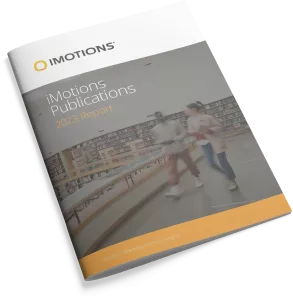-
How Soundtracks Shape What We See: Analyzing the Influence of Music on Visual Scenes Through Self-Assessment, Eye Tracking, and Pupillometry
This article presents two studies that deepen the theme of how soundtracks shape our interpretation of audiovisuals. Embracing a multivariate perspective, Study 1 (N = 118) demonstrated, through an online between-subjects experiment, that two different music scores (melancholic vs. anxious) deeply affected the interpretations of an unknown movie scene in terms of empathy felt toward […]
-
Modality-Transferable Emotion Embeddings for Low-Resource Multimodal Emotion Recognition
Despite the recent achievements made in the multi-modal emotion recognition task, two problems still exist and have not been well investigated: 1) the relationship between different emotion categories are not utilized, which leads to sub-optimal performance; and 2) current models fail to cope well with low-resource emotions, especially for unseen emotions. In this paper, we […]
-
The influence of taste-congruent soundtracks on visual attention and food choice: A cross-cultural eye-tracking study in Chinese and Danish consumers
Sound can have a profound impact on our eating experience and behavior. The term “sonic seasoning”, arising from crossmodal correspondences, denotes the tendency for soundtracks with congruent taste/flavor attributes to alter people’s food perception. However, the implicit behavior effects of such sound-taste correspondence have not yet been tested. Employing eye-tracking technology, the current study explored […]
-
Visual Preference for Biological Motion in Children and Adults with Autism Spectrum Disorder: An Eye-Tracking Study
Participants with autism spectrum disorder (ASD) (n = 121, mean [SD] age: 14.6 [8.0] years) and typically developing (TD) controls (n = 40, 16.4 [13.3] years) were presented with a series of videos representing biological motion on one side of a computer monitor screen and non-biological motion on the other, while their eye movements were recorded. As predicted, participants […]
-
Detecting Differences Between Concealed and Unconcealed Emotions Using iMotions EMOTIENT
Biometric analysis is everywhere – even in our cell phone security through facial and fingerprint recognition. It has recently become widely useful in forensic settings as well, being used for facial, fingerprint/palmprint, iris, and voice identification1. Using the iMotions Facial Expression Analysis software, I looked at detection differences between concealed and unconcealed emotions when presented […]
-
Sponsor message processing in live broadcasts—A pilot study on the role of game outcome uncertainty and emotions
Live sport broadcasts can evoke emotions in consumers and allow companies to reach their audience in environments that allow for automatic processing of brand messages. However, only few studies have applied psychophysiological methodologies to assess how the live nature of a competition and viewers’ emotions affect the processing of sponsor messages, and prior research has […]
-
Attraction comes from many sources: Attentional and comparative processes in decoy effects
The attraction effect emerges when adding a seemingly irrelevant option (decoy) to a binary choice shifts preference towards a target option. This suggests that choice behaviour is dynamic, i.e., choice values are developed during deliberation, rather than manifesting some pre-existing preference set. Whereas several models of multi alternative and multiattribute decision making consider dynamic choice […]
-
Emotion assessment using Machine Learning and low-cost wearable devices
The advancement in bioelectrical measurement technologies and the push towards a higher impact of the Brain Computer Interfaces and Affective Computing in the daily life have made non-invasive and low-priced devices available to the large population to record physiological states. The aim of this study is the assessment of the abilities of the MUSE headband, […]
-
Protocol for a single-centre, parallel-group, randomised, controlled, superiority trial on the effects of time-restricted eating on body weight, behaviour and metabolism in individuals at high risk of type 2 diabetes: the REStricted Eating Time (RESET) study
The aim of this study is to investigate the effects of time-restricted eating (TRE) on change in body weight and describe changes in behaviour and metabolism in individuals at high risk of type 2 diabetes. Methods and analysis The REStricted Eating Time (RESET) study is a randomised controlled parallel-group open-label trial. 100 women and men […]
-
Human and machine validation of 14 databases of dynamic facial expressions
With a shift in interest toward dynamic expressions, numerous corpora of dynamic facial stimuli have been developed over the past two decades. The present research aimed to test existing sets of dynamic facial expressions (published between 2000 and 2015) in a cross-corpus validation effort. For this, 14 dynamic databases were selected that featured facial expressions […]
Research Report 2023
In-depth look at the scientific landscape as powered by iMotions software, showcasing groundbreaking research and the impact of our tools in various scientific and industrial fields.

Share Your Research

850+ universities worldwide with an iMotions human behavior lab
73 of the top 100 highest ranked universities
710+ published research papers using iMotions
iMotions is used for some of the most interesting human behavior research studies carried out by top researchers around the world. Contact us to have your publication featured here.
The authors of these publications have used iMotions as a software tool within their research.
“Software should be cited on the same basis as any other research product such as a paper or a book; that is, authors should cite the appropriate set of software products just as they cite the appropriate set of papers” (Katz et al., 2020).
We therefore encourage you to cite the use of iMotions where appropriate.
How to cite iMotions
APA
iMotions (10), iMotions A/S, Copenhagen, Denmark, (2024).
Note: adjust the version and year where relevant.
5 Most Popular Blogs
Learn How to Conduct Human Behavior Research with iMotions
Publications
Read publications made possible with iMotions
Blog
Get inspired and learn more from our expert content writers
Newsletter
A monthly close up of latest product and research news





